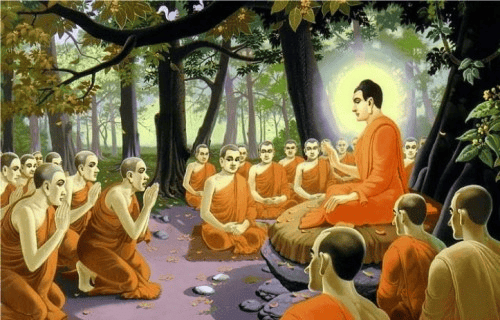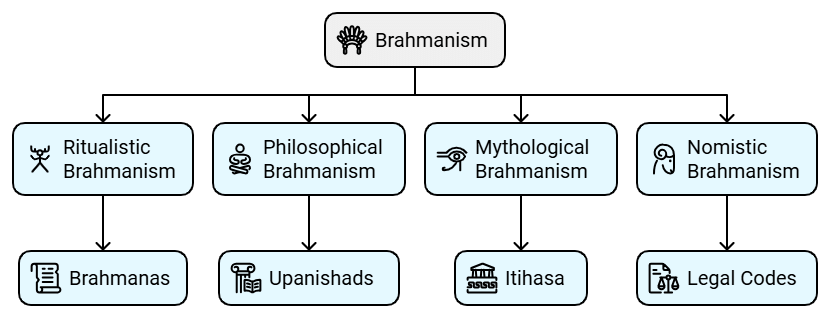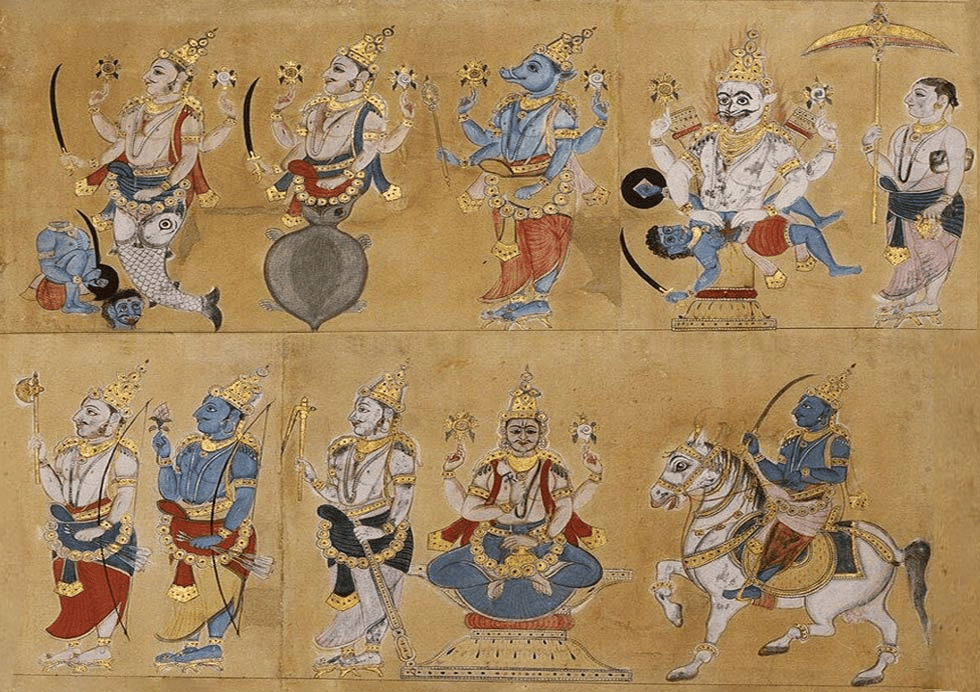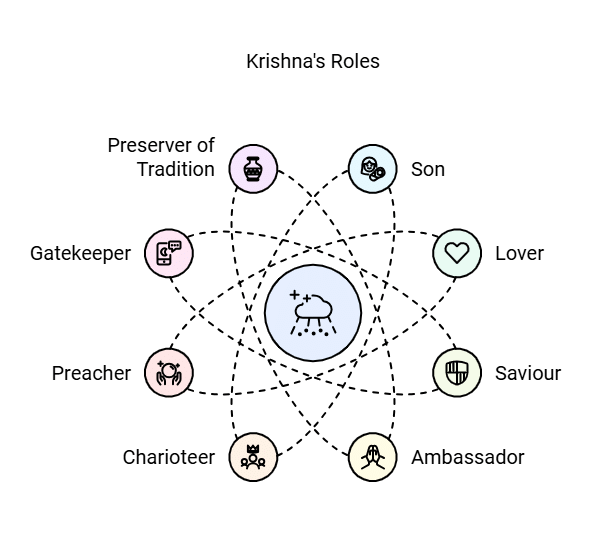Bhagavatism and Brahmanism | Famous Books for UPSC Exam (Summary & Tests) PDF Download
| Table of contents |

|
| Brahmanism |

|
| Origin of Brahmanism |

|
| Tracing the journey of Brahmanism |

|
| Phases of Brahmanism |

|
| Bhagvatism |

|
| Need OF Bhagvatism |

|
| Essence OF Bhagavatism |

|
| Causes of Popularity |

|
Brahmanism
- Sir Monier Williams explains that Brahmanism is a spiritual belief that connects God with the universe.
- In this view, Brahma is seen as a creator, but only as the first step of existence, evolving from the one Spirit, from which everything else has come.
- According to the Satapatha-brahmana (from the Sukla Yajurveda):
- "In the beginning, Brahma was the universe."
- "He created gods and placed them in different worlds."
- "After creating these worlds, he thought about how to fill them completely."
- "Then, he filled them with both form and name."
- "Anyone who understands these two important aspects of Brahma becomes a significant manifestation themselves."

Origin of Brahmanism
- Brahmanism is believed to have originated during Vedic times.
- It teaches that all forces and phenomena of nature are identified with one spiritual being, which is considered the "only real entity."
- Proponents of Brahmanism refer to their religion as Arya-dharma (the religion of the Aryas) or Vaidika-dharma.
- It is interesting to observe how the basic doctrines of Brahmanism have crystallized into a definite form since its origin.
The Concept of Brahman in Vedic Times
- During Vedic times, people believed in one Supreme Being.
- The composers of hymns were curious about the Infinite and began personifying elements of nature such as the Sky, Sun, Fire, Air, Water, and Earth.
- They felt a deep connection with the 'Spirit' (Atman), which they believed vivified their bodies with the breath of life.
- This mysterious presence was enshrined in their conscience and was identified with the divine creative impulse inspiring the hymn composers.
- The 'Spirit' was also linked to the spiritual efficacy of the hymns, the mystic power of divine knowledge, and prayer.
This all-pervading, vague spiritual power and presence, unbound by personality and individuality, became a reality. The Breath of Life (Atman) was named "Brahman," symbolizing a pure essence that diffused itself everywhere and constituted everything. Men, gods, and the visible world were seen as mere manifestations of Brahman.
This concept formed the fundamental doctrine of Brahmanism.
Tracing the journey of Brahmanism
The exact date and place of origin for Vedic thought is uncertain, but two theories have been proposed:
1. The Indo-Aryan Migration Theory
- This theory suggests that Vedic thought originated in Central Asia, specifically around the Kingdom of Mitanni (modern-day northern Iraq, Syria, and Turkey).
- It proposes that this vision came to India during the decline of the Indus Valley Civilization, roughly between 2000-1500 BCE.
2. The Out of India Theory (OIT)
- The OIT argues that the Indus Valley Civilization developed the Vedic vision and exported it to Central Asia.
- It claims that the vision was later brought back to India with the Indo-Aryan Migration.
- This theory is supported by the presence of names of gods, like Indra, in Central Asia and the establishment of the concept of cosmic order there.
It is believed that around the 3rd millennium BCE, nomadic Aryan tribes migrated into Central Asia. The Indo-Iranians settled in the Iranian Plateau, while the Indo-Aryans continued southwards to the Indian subcontinent. The term "Aryan" referred to a class of people meaning "free" or "noble."
Phases of Brahmanism
Brahmanism is a complex system with four distinct yet interconnected phases: 
Ritualistic Brahmanism
- Sacred Texts: Ritualistic Brahmanism is guided by sacred texts known as the “ Brahmanas,” which are an integral part of the Vedas. These texts provide detailed instructions for conducting complex sacrificial ceremonies.
- Examples of Brahmanas: (a) Aitareya Brahmana (Rig Veda) (b) Satapatha Brahmana (Yajur Veda) (c) Tandya Brahmana (Sama Veda) (d) Gopatha Brahmana (Atharva Veda)
- Purpose: The Brahmanas contain divine knowledge adapted to guide Brahmins in the performance of sacrificial rituals.
- Early Vedic Beliefs: In the early Vedic period, it was believed necessary to propitiate and maintain the energies of nature through invigorating offerings of food. As these energies were later personalized as divine manifestations, the practice continued.
- Human Sacrifice: Initially, human sacrifice was part of the Ritualistic Brahmanical system but was later substituted with the sacrifice of animals such as horses, oxen, sheep, and goats.
- Sacrificial Practices: Large numbers of animals were tied to sacrificial posts (yupa), some were killed, and others liberated at the end of the ceremony. One significant idea in the Brahmanas is that gods were considered mortal until they conquered Death through sacrifices.
Philosophical Brahmanism
- Nature of Philosophy: Philosophical Brahmanism is viewed as a spiritual doctrine centered around a universally diffused essence, Brahma, devoid of ritualistic elements.
- Core Texts: The Upanishads are the foundational texts of this phase, laying the groundwork for various philosophical systems.
- Philosophical Systems: The Upanishads inspired three main philosophical systems: (a) Nyaya with Vaiseshika (b) Sankhya with Yoga (c) Vedanta with Mimansa
- Goal of Philosophy: These systems aim to liberate the human spirit from the cycle of rebirth and reunite it with the Supreme Spirit, similar to a river merging with the ocean.
- Concept of Spirit: Most thinkers in Philosophical Brahmanism agree that the spirit or soul is eternal. The individual spirit (jiva) or Self (Atman) is identical to God’s Spirit, which is limited and personalized by Illusion.
- Cycle of Existence: Life is viewed as a small segment of an infinite cycle of existence. Actions, whether good or bad, lead to consequences that require appropriate rewards or punishments.
- Vedanta Philosophy: The Vedanta philosophy, often associated with pantheism, is popular among Brahmanism adherents. It emphasizes the non-duality and non-plurality of the Spirit, believing in one eternal Spirit (Atman or Brahman) rather than many.
- Threefold Trinity: Vedanta also posits a threefold Trinity of spiritual essences, corporeal envelopes, and dominating qualities that constitute one personal God and every human personality.
- Guna Concept: The term “Guna” refers to the three qualities constituting Prakriti: Activity (Rajas), Goodness (Sattva), and Indifference (Tamas).
Mythological Brahmanism
- Mythological Phase: The mythological phase of Brahmanism is marked by the compilation of legendary heroic poems, known as Itihasa, including the Mahabharata and the Ramayana. This phase likely developed alongside Buddhism.
- Evolutionary Doctrine: The Brahmans in this phase were focused on evolving their teachings to encompass existing superstitions and develop a popular mythology.
- Hierarchical Existence: Brahmanism traces a hierarchy of existence from man to Brahma, the primeval male god and the first evolution, who is seen as the Evolver of all inferior forms.
Polytheistic Gods
The Incarnations of Vishnu
The incarnations of Vishnu are believed to be descents on earth undertaken to preserve the world during pressing emergencies, especially when threatened by evil demons. 
There are four kinds and degrees of these incarnations:
- Full Descent: An example is Krishna, a hero in the Mahabharata.
- Partial Descent: This involves half of the god's nature, as seen in Rama, the hero of the Ramayana.
- Quarter Descent: An example is Rama's brother Bharata.
- Eighth-Part Descent: This includes Rama's other brothers, Lakshmana and Shatrughna.
Brahma and Siva
- Human Incarnations: Unlike Vishnu, Brahma and Siva do not have human incarnations. However, Brahma is represented by priests known as Brahmans.
- Local Manifestations: There are instances of local manifestations and descents of Siva in human form, such as Siva and Veerabhadra.
- Sons of Siva: Siva has two sons, Ganesha and Subrahmanya, who serve as generals of the celestial armies. In contrast, Vishnu has no sons except in his human incarnations.
- Chief Temple Deities: Forms of Vishnu, Siva, and their consorts, along with Ganesha, Subrahmanya, and Hanuman, are the main deities worshipped in Indian temples.
- Divine Hierarchy: There is a vast array of divine and semi-divine beings, both good and evil, each revered or feared. All are subject to the universal law of re-absorption into the one divine universal Essence (Brahma).
Nomistic Brahmanism
- Emergence of Codes: Nomistic Brahmanism marks a period when Brahman scholars composed legal codes and established precise rules to organize social life, coordinate different social orders, and regulate daily domestic activities.
- Rigidity of Rules: The religious and philosophical thought during this period is characterized by the strictness of the rules governing every aspect of social and domestic life. These rules are encapsulated in three main codes.
- Code of Manu: Originally a local code, the Code of Manu contains rules and precepts that may have been authored by different individuals, some possibly dating back to the fifth century BC or earlier. It emphasizes that the Veda and the traditions of Veda scholars are the root of all law.
- Code of Yajnavalkya: This code introduces additional rules, some of which are likely from the first or second century AD. It is commonly associated with its commentary, the Mitakshara.
- Code of Parasara: The Code of Parasara outlines special laws suited for the fourth age of the world, known as Kali, which is considered a degenerate period.
- Interconnection of Law and Religion: The three principal codes reflect the close interconnection of law, politics, and social life with religion and religious ordinances. Manu’s doctrine, which categorizes men into distinct types (Brahmans, Kshatriyas, Vaisyas, and Sudras), reinforces the idea that these groups are fundamentally different from birth to death.
Hence, Brahmanism is a belief system that emerged from the Vedas during the late Vedic Period. It has its roots in the Indus Valley Civilization, following the Indo-Aryan Migration.The origin of Brahmanism is a topic that has led to many different opinions. Over the years, its interpretation has changed, showing various philosophical views. When looking back at the beginnings of Brahmanism, it is clear that it started as a spiritual teaching that linked God with the universe, describing it as a universal being. However, as time progressed, the understanding of Brahmanism shifted from a focus on rituals to a more rule-based approach, known as Nomistic Brahmanism, which changed its original perspective. What began as a way of life and belief system has evolved into a full-fledged religion over time. Brahmanism was created to help people recognize the forces and phenomena of nature as connected to one spiritual entity, which has now developed into a complete religion. Like many religions, Brahmanism was formed to address significant social issues, providing answers to questions about the origin of the universe and a person's place within it.
Bhagvatism
- Talking about Bhagvatism, it has a unique origin. The arrival of many foreigners after the fall of the Mauryan Empire created a cultural shift for Aryanism.
- A significant number of these foreigners embraced Buddhism because it was a simpler belief system compared to Hinduism.
- Some foreigners also began to follow this new belief, although the exact reasons for its emergence remain unclear.
- Over time, this movement evolved into the Vasudeva Krishna cult during the Gupta period.
- There is debate about how Bhagvatism developed, with some suggesting that the Bhagavata cult from the north-west merged with the Krishna cult of the Abhiras in the Mathura region.
- A key aspect of this religious movement is devotion or love for God, which is referred to as the Dionysian perspective in the West.
- This idea of devotion was not significant in the Aryanism of ancient Hinduism, where the main focus was the Apollonian perspective, rather than the Dionysian.
- Initially, it is unclear how this branch of Hinduism developed, but eventually, it blended with traditional Aryanism or Brahminism.
- The Vasudeva-Krishna cult is rooted in the epic Mahabharata, making it one of the foundations of Hindu religious beliefs that continue to exist today.
Need OF Bhagvatism
- Brahmanism had turned into mostly an intellectual belief system. It overlooked the importance of emotional connection. The main ideas of Brahmanism were impersonal and theoretical. It became too strict, focused on dogma, rituals, and formalities, making it hard to follow. People who needed a more ethical and affectionate faith that could provide both emotional fulfillment and moral direction found Brahmanism unhelpful. In this situation, the Bhakti movement, which emphasized love for God, emerged as a positive response.
- There was a demand for a popular hero who could unite people against the strong influence of heterodox sects that challenged Brahmanism in the 6th century B.C.
- There was also a need to integrate new ethnic and tribal groups, including foreigners. The goal was to bring these groups, known as sramans, sanyasins, parivrajakas, or yogis, back into the Aryan community.
- It was important to regain respect for and adherence to varnashrama dharma to establish social laws. This would help ensure the smooth functioning of society and promote its overall well-being.
Essence OF Bhagavatism
- Bhagvatism teaches that actions done with an attachment to their results create a cycle of endless rebirths.
- Nishakama karma refers to selfless action, which leads to liberation and true renunciation.
- True bhakti is the loving and selfless pursuit of a personal God, which encourages actions that benefit others.
- Pursuing one’s varnasharma-dharma, or social responsibilities, is considered one’s true duty.
- God takes on human or other forms at different times to support dharma and eliminate sin.
- Every person has the right to attain moksha as long as they seek refuge in God.
Causes of Popularity
- Vasudeva-Krishna cult gained immense popularity due to Krishna's embodiment of diverse human roles and emotions.
- Appeals to both Aryans and non-Aryans through his various roles and actions.
Krishna's Roles and Appeal

(a) As a Son
- Krishna as Devaki's and Yashoda's son, fulfilling the emotional bond of motherhood.
- His role in protecting cows, revered by both Aryans and non-Aryans.
(b) As a Lover
- Krishna's divine love for the gopis and young women, representing human desires and emotions.
(c) As a Saviour
- Killing Kansa and demons to protect the oppressed.
- Challenging Vedic God Indra to safeguard non-Aryans.
- Saving Draupadi's honour, protecting women's dignity.
(d) As an Ambassador
- Krishna's role as an ambassador for the Pandavas, showcasing loyalty and diplomacy.
(e) As a Charioteer
- Driving Arjuna's chariot in the Kurukshetra battle, symbolizing guidance and support.
(f) As a Preacher
- Delivering teachings in Kurukshetra, emphasizing spiritual wisdom.
(g) As a Gatekeeper
- Acting as a gatekeeper during the Pandavas' Yajna, facilitating rituals.
(h) As a Preserver of Tradition
- His presence during sacrifices, upholding traditional practices.
(i) As a Friend
- Krishna's friendship with the poor, cowherds, and Sudama, illustrating compassion and camaraderie.
(j) As a Musician
- Playing the flute, representing joy and cultural richness.
(k) As a Just King
- Ruling Dwarka with justice and fairness.
(l) As a Spiritual Guide
- Emphasizing the combined pursuit of knowledge, action, and devotion, making Brahminical religion more flexible and accessible.
Krishna, often considered even more popular than Rama, is a unique and universal divine figure who fulfills many human needs. As a playful child, he brings joy and satisfies the caring instincts of Indian women. As a loving companion, he represents romantic dreams in a society with strict rules about relationships. On the battlefield of Kurukshetra, as Arjuna's charioteer, he helps those who seek his guidance and even saves sinners from the cycle of rebirth if they have deep faith in him.
|
745 videos|1444 docs|633 tests
|
FAQs on Bhagavatism and Brahmanism - Famous Books for UPSC Exam (Summary & Tests)
| 1. What are the key differences between Brahmanism and Bhagavatism? |  |
| 2. Why did Bhagavatism emerge as a significant movement in ancient India? |  |
| 3. How did the philosophy of Bhagavatism evolve over time? |  |
| 4. What role did the concept of bhakti play in the transition from Brahmanism to Bhagavatism? |  |
| 5. In what ways did Bhagavatism influence later religious movements in India? |  |





















